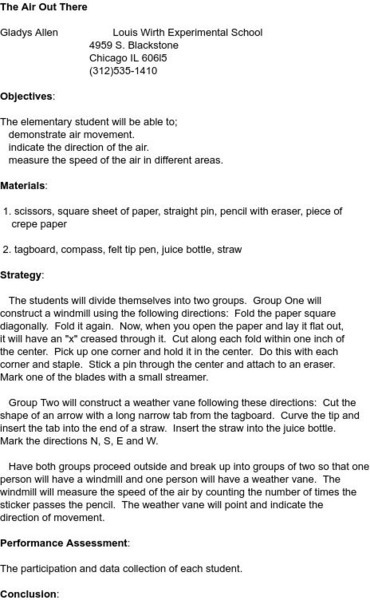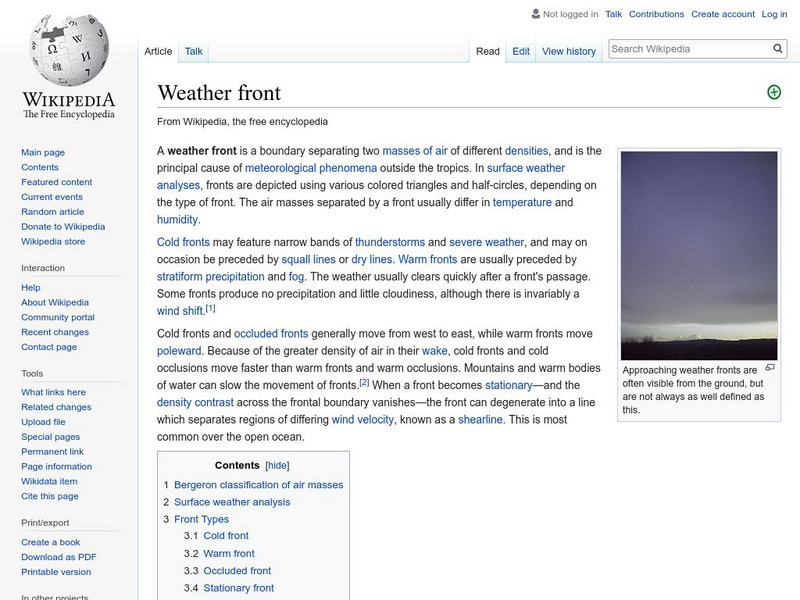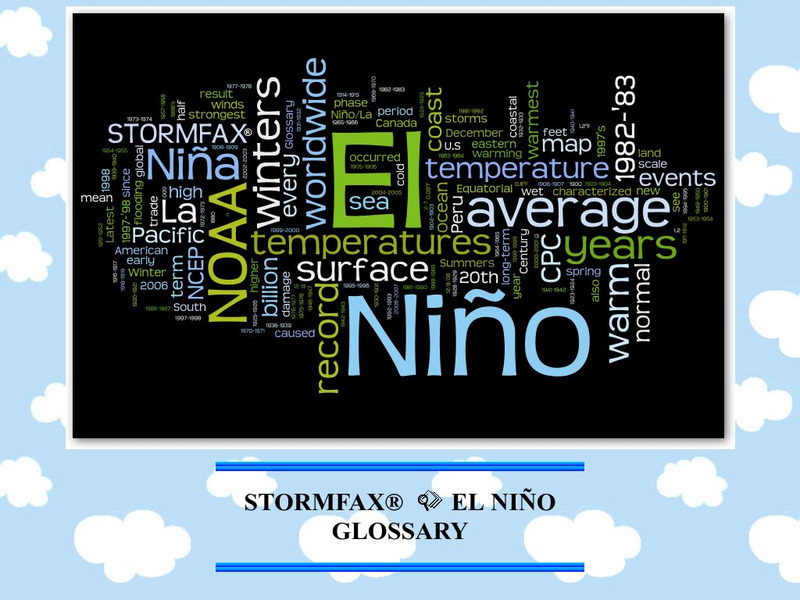Science and Mathematics Initiative for Learning Enhancement (SMILE)
Smile: The Air Out There
Cooperative learning activity in which students will create a windmill and a weather vane. Students will find the direction of wind and the speed relative to the spinning windmill. Great for K-2.
Weather Wiz Kids
Weather Wiz Kids: Wind
What is wind? How is it caused? This site offers simple answers to many common questions about wind as well as a chart of the Beaufort scale, which "is an empirical measure for the intensity of the weather based mainly on wind power."
Missouri Botanical Garden
Missouri Botanical Garden: Waves
This site from the Missouri Botanical Garden provides a brief description of how waves form and move. Click on the "waves" link in the toolbar to the left. This site is basic, but very informative. Includes colorful animations...
Kidport
Kidport Reference Library: Energy
A simple introduction to energy, offering information on hydro-electric energy, fossil fuels, nuclear power, solar energy, and wind energy.
Wikimedia
Wikipedia: Weather Front
This Wikipedia site tells all about weather fronts, or boundaries between two air masses with differing characteristics. Includes many hyperlinked terms to additional information on related subjects.
Weather Wiz Kids
Weather Wiz Kids: Wind
Wind is air in motion. It is produced by the uneven heating of the earth's surface by the sun. Since the earth's surface is made of various land and water formations, it absorbs the sun's radiation unevenly. Two factors are necessary to...
PBS
Pbs Teachers: Balancing Balls on Air
Investigate how the force of moving air from a blow dryer interacts with the force of gravity to keep a ping-pong ball perfectly balanced in midair.
Other
Stormfax: El Nino Glossary
This site offers definitions for terms related to El Nino, including information on southern oscillation and its relationship to the trade winds.
Education.com
Education.com: Learn Where Wind Comes From
[Free Registration/Login Required] Directions for a simple activity that will help students understand where wind comes from.
Center of Science and Industry
Cosi Columbus: Paper Cup Anemometer
Make your own anemometer like meteorologists use to measure the speed of wind. Includes full list of materials, procedures, and scientific explanation of what makes wind.
ClassFlow
Class Flow: Sources of Energy
[Free Registration/Login Required] In this flipchart, students are introduced to the different sources of energy produced on earth. Students will learn the names of different energy sources, the mechanisms of how each works along with...
ClassFlow
Class Flow: Tornado Experiment
[Free Registration/Login Required] This flipchart has a full lesson plan (with standards and adaptations) about Tornadoes. An experiment is included with materials description, pictures, and every step. It is intended to be easy to read...
Other
National Pollutant Inventory: Background Information
This site focuses on water and air pollution in Australia, with a brief mention of sea breezes.
Energy4Me
Energy4me: Wind Energy
Learn about the alternative energy source, wind energy. Find out the history of this renewable resource and how it works to convert wind energy into electricity.
ClassFlow
Class Flow: Weather Hurricanes
[Free Registration/Login Required] This flipchart describes hurricanes and the processes that come together to create hurricanes. It tells us the right precautions to take if a hurricane is coming our way!
ClassFlow
Class Flow: Weather Conditions
[Free Registration/Login Required] This flipchart is a beginning of a unit on weather. The flipchart contains information about fronts, air masses, and wind. There is an assessment quiz at the end.
Cosmo Learning
Cosmo Learning: Ocean Currents
The atmosphere forces the ocean in three ways: addition and removal of heat, precipitation and evaporation, and wind stress. The former two processes influence the density of sea water. Gravity acts on these density differences to cause...
Ducksters
Ducksters: Earth Science for Kids: Weather: Wind
Kids learn about wind including how it is formed, how it is measured, local and global winds including prevailing, westerlies, trade, and polar easterlies.
Kansas State
Kansas State University and Usda: Wind Erosion Control
This website provides numerous pictures and brief descriptions that illustrate a variety of ways to control wind erosion. Clicking on a picture will enlarge it to provide a better view.
Ducksters
Ducksters: Earth Science for Kids: Erosion
Study the subject of erosion including water, wind, and glacial erosion, fun facts, human causes, and controlling it on this site.
Ducksters
Ducksters: Kids Science Projects and Experiments: Wind
Kids learn by experimenting with science. Project showing how wind is created.
SMART Technologies
Smart: Weather
Students will learn about the six common weather conditions: sunshine, wind, rain, snow, fog, and thunderstorms.
Other
Unep/siem D2 Weather
This site offers information on the effects of weather on islands. There is some mention of sea breezes.
NASA
Nasa: Looking at Earth From Space Prevailing Westerlies
This site from NASA provides a basic definition for what prevailing westerlies are.






















